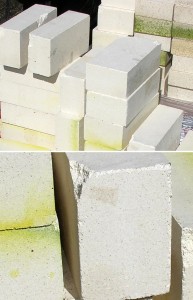Chipped off edges on fire-bricks ?
Question :
I live on a small island off the BC coast in Canada, and if I can figure it out, one of your ovens will be well used and much needed.
One question if you would … There’s a guy close by who’s selling a lot of used fire brick. But most all of it is chipped along the edges, which will not result in as tight a fit as with new.
Would these used, chipped bricks pose any sort of technical problem or just cosmetic?
I look forward to seeing your plans. I’d prefer to receive the info over the Internet if the option is still possible. Your site is great.
All the best,
ak
Answer :
Hi Alex,
Thank you for your nice words about our work.
Does he have many of the already used before firebricks? How much is he selling them for?
To go around such minor problem, always use the better side on the inside. The worst firebricks can be used in the floor, along the sides and under the walls around. Set these aside right at start. It’s common to do it this way as there are always many chipped firebricks also among new ones on a pallet. Sort further: set the best firebricks for the arches. The rest can go into the walls. Easy as one – two – three.
If in doubt email me a couple photos of the detail and I will have a look and let you know.
Rado

Fire bricks with chipped edges & corners (might be normally used.)
Question :
I’ve found two guys now.
One guy has 1500 @ $1.50 ea. used.
The latest find is guy who calls them chimney bricks. They’re solid and cream colored. He says he took down a 40 yr old chimney and these were the bricks. He only want a quarter $0.25 per brick – which would be great if they are chimney bricks – he has 500. BUT, is there any way to identify these “chimney bricks” as fire brick or not?
Thanks again Rado, you’re a righteous dude!
Best,
ak
Answer :
Hi AK,
Firebricks are very often called by different names (it depends who works with them, firebricks quickly adopt a nick name for the subject), e.g. fire-clay bricks, chimney bricks, fireplace bricks, shamot bricks, refractory bricks, heat resistant bricks, heavy/dense kiln bricks (to distinct them from the light in mass insulating kiln firebricks) and so on.
By looking at the image, those bricks are pretty good so to speak. Not too worry if more/most of them are like that you will make clean firing part by looking at it from the inside. Even though I cannot see the close up detail to spot the while pebbly grog totally distinctive for firebricks (although only/best seen in the brick’s inside, e.g. when the brick is cut and any dust washed off), surely these look like the right firebricks. It’s positive.
Exactly as on the image – very often a green sort of algae growing on the bricks is noticeable; when stored while facing outdoors weather, within 2-3 weeks, firebricks start to grow the mini photosynthetic like plants. It starts with yellow color which gradually turns to nice green, it is normal and in fire it burns-out immediately.
Are these the 3″ – 2.5″ = 75mm or 64mm thick bricks? Probably so.
Bloody good price. Anyway only ask what source was the chimney attached to, basically only politely find out / ask, (you don’t want to offend a naturalist with this kind of question! ;-), whether it wasn’t used in a kiln etc. where for instance a toxic material was burned or heated. Because in this world industries or incinerators that heat up lead based pigments or acids logically do normally exist (contaminate bricks) and healthy culinary art isn’t mixing well with those alike industrial materials … just a precaution for healthy living.
Simply turn the bricks with their better sides inwards. That is hot to resolve it.
Questions end :
Wow thanks Rado!!!
The bricks are from an older house in Vancouver so I think they should be ok, toxic-ally speaking.
I’ll go look at them and keep you posted. Yours small island off the British Columbia coast in Canada sounds wonderful Mate!
Thanks again,
ak
Respond to the Chipped off edges on fire-bricks ? article:
2 Comments
Sorry, the comment form is closed at this time.
Refractory supplier, do you have contacts on them and where are you located? Have you noticed chipped or seconds fire bricks being sold for better price in some?
Pingback Firebricks are actually fire clay bricks. Thermal conductivity. Cutting with diamond wheel.
I went to a local Habitat for Humanity Restore and they had firebrick in many sizes. There was 9″x4.5″x3″ ($1.00 US), 9″x9″x3″, what looked like 6″x6″x9″ and some very big 3″ thick pieces. This might be true where ever restores exist. I can see some of the bulky stuff might be good for verticals as well as the floor of the oven. I have noticed that the 3g MTo pages have not had a lot of activity from you I hope all is well with you and yours. I have had to put off building while.
Best of luck,
Phil
By Phil